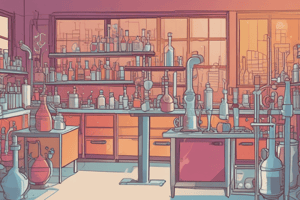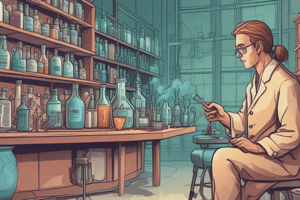Podcast
Questions and Answers
Which substance listed cannot be directly identified as an acid or base using olfactory indicators?
Which substance listed cannot be directly identified as an acid or base using olfactory indicators?
- Onion extract
- Vanilla essence
- Hydrochloric acid (HCl) (correct)
- Sodium hydroxide (NaOH) (correct)
Which solution is not a base?
Which solution is not a base?
- Potassium hydroxide (KOH)
- Calcium hydroxide (Ca(OH)2)
- Ammonium hydroxide (NH4OH)
- Acetic acid (CH3COOH) (correct)
What happens to the odour of vanilla essence when a few drops of dilute HCl are added?
What happens to the odour of vanilla essence when a few drops of dilute HCl are added?
- The odour intensifies
- The odour turns unpleasant
- There is no change in odour
- The odour diminishes (correct)
Which indicator would turn blue when in contact with a base?
Which indicator would turn blue when in contact with a base?
How would the odour of clove oil change if it was tested with a strong base like NaOH?
How would the odour of clove oil change if it was tested with a strong base like NaOH?
What is used to test for acids and bases in Activity 2.2?
What is used to test for acids and bases in Activity 2.2?
Which solution would typically exhibit no significant odour change when tested with both dilute HCl and NaOH?
Which solution would typically exhibit no significant odour change when tested with both dilute HCl and NaOH?
In Activity 2.2, what is the role of dilute HCl and NaOH solutions when added to the cloth strips?
In Activity 2.2, what is the role of dilute HCl and NaOH solutions when added to the cloth strips?
What is the expected change when you add dilute NaOH to a cloth strip soaked with onion extract?
What is the expected change when you add dilute NaOH to a cloth strip soaked with onion extract?
Why are bubbles formed in the soap solution in Activity 2.3?
Why are bubbles formed in the soap solution in Activity 2.3?
Which combination is correct regarding the reaction of phenolphthalein and the listed solutions?
Which combination is correct regarding the reaction of phenolphthalein and the listed solutions?
What observation is made when a burning candle is brought near a gas-filled bubble from Activity 2.3?
What observation is made when a burning candle is brought near a gas-filled bubble from Activity 2.3?
Which equation summarizes the reaction of a metal with an acid as described in Activity 2.3?
Which equation summarizes the reaction of a metal with an acid as described in Activity 2.3?
In Activity 2.4, what is added to the test tube containing zinc metal?
In Activity 2.4, what is added to the test tube containing zinc metal?
What is the chemical name of the bubble-producing gas in Activity 2.3?
What is the chemical name of the bubble-producing gas in Activity 2.3?
During Activity 2.2, how can one determine if vanilla and clove can be used as olfactory indicators?
During Activity 2.2, how can one determine if vanilla and clove can be used as olfactory indicators?
Flashcards are hidden until you start studying
Study Notes
Understanding Acids and Bases
Identifying Acids and Bases
- Acids and bases can be identified using indicators, which change color in response to acidic or basic conditions.
- Red litmus, blue litmus, phenolphthalein, and methyl orange are common indicators used to test for acids and bases.
Olfactory Indicators
- Olfactory indicators are substances that change odor in acidic or basic media.
- Onion, vanilla, and clove can be used as olfactory indicators.
- Onion cloth strips can be used to test for acids and bases by observing changes in odor.
Reaction of Acids and Bases with Metals
- Acids react with metals to produce hydrogen gas and form a salt.
- The reaction can be summarized as: Acid + Metal → Salt + Hydrogen gas
- Examples of acids that react with metals include HCl, HNO3, CH3COOH, and H2SO4.
- Zinc metal reacts with dilute sulphuric acid to produce hydrogen gas, which can be tested by burning.
- The reaction of a metal with an acid produces a salt and hydrogen gas.
Reaction of Bases with Metals
- Sodium hydroxide solution reacts with zinc metal to produce a salt and hydrogen gas.
- The reaction can be summarized as: Base + Metal → Salt + Hydrogen gas
Studying That Suits You
Use AI to generate personalized quizzes and flashcards to suit your learning preferences.




